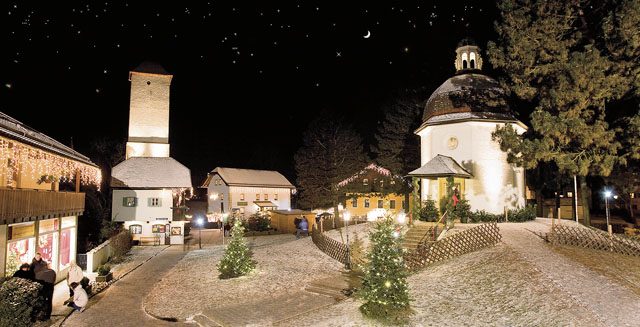
The Silent Night Memorial Chapel in Oberndorf near Salzburg, Austria, was built from 1924 to 1936. Each year it lures thousands of visitors. It is open 8:30 a.m. to 6 p.m. daily.
During Advent season, the world’s most popular Christmas song “Silent Night” can be heard all over the world in all languages.
The song originated in Austria. On the afternoon of Christmas Eve 1818, the priest of St. Nikolaus Church in Oberndorf near Salzburg, Joseph Mohr, tried to play the organ. He was very desperate because there was only a scratching sound coming out of the instrument. The church and the organ were damaged by high waters of the Salzach River.
For Mohr, a Christmas celebration without music was impossible, so he gave the text of a poem he wrote in 1816 to his friend and local teacher Franz Xaver Gruber and asked him to compose a melody for it. He chose this poem because it was in German and easy to understand for the local population, who mainly were seamen on the Salzach River. During the priest’s time, the church liturgy was mainly in Latin, not to be understood by those poor people.
Just in time for the midnight service, Gruber presented Mohr an easy melody for two soloists with choir and guitar accompaniment.
The local people liked the “Stille Nacht” song performed by the priest singing tenor and playing the guitar, and the teacher singing bass.
In fall of the following year, Mohr left Oberndorf to be stationed in another town in the state of Salzburg. The new Christmas song was forgotten. But in 1824, when the organ needed repair work again, the organ builder found the text and notes of “Stille Nacht” in the choir loft. He asked Gruber for a copy to take with him on his trips. This way, many musicians from Tyrol, who were traveling throughout Europe, included the song in their repertory.
In 1832, a publisher from Leipzig printed “Stille Nacht” for the first time, but the names of Mohr and Gruber were not mentioned. They never knew what a success their song, even in America, was.
Joseph Mohr, the priest, died at the age of 55 as a poor man. Many years later, a controversy about the authorship of the original version was set aside.
Today, a monument of Joseph Mohr in Oberndorf honors his work.
To date the Christmas song “Stille Nacht” has been translated to about 300 languages and dialects.
Due to bad damages by high waters, St. Nicholas Church had to be torn down between 1906 and 1913. In the first half of the 20th century, the village of Oberndorf was placed about 800 meters upstream to secured, high-water areas, and a new church was built.
Between 1924 and 1937, a Silent Night Memorial Chapel was erected on the grounds of the former church. About 150,000 persons from throughout the world visit the chapel each year.
In 2011, the Austrian UNESCO commission added the song to the national list of intangible cultural heritage and recommended it for the general list of international UNESCO cultural heritage.


